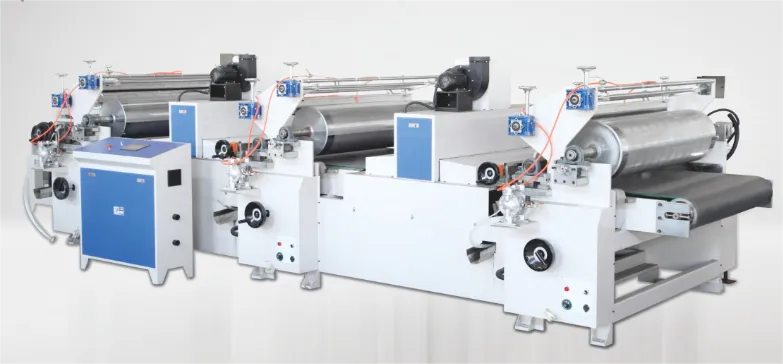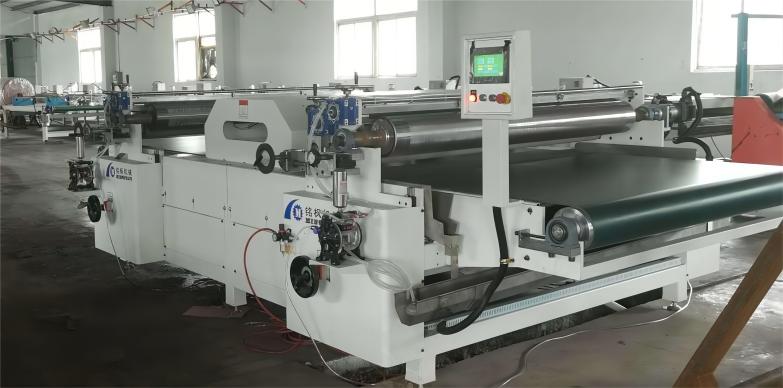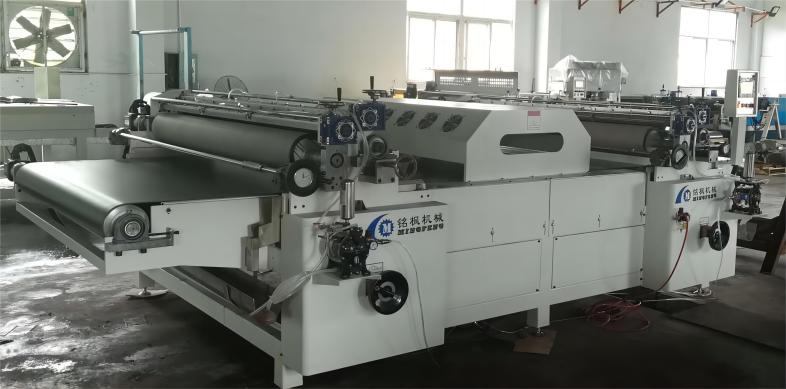The essence of wood grain printing is to transfer a continuous pattern simulating wood grain onto the surface of wood or board materials (such as MDF, plywood, PVC, and metal substrate cladding) with high repeatability, stable ink volume, and satisfactory adhesion.
The core equipment for achieving this goal is a wood grain printing machine (also often referred to as a wood grain roller printer, wood grain gravure printer, or wood grain transfer printer), which is coordinated with upstream units such as dust removal, primer coating, and pre-baking, and downstream units such as curing, varnishing, and embossing.
The following systematically explains the principles, processes, equipment, formulations, parameters, and quality.
What is wood grain printing?
How does it differ from conventional flat printing?
Wood grain printing involves transferring a pre-designed wood grain pattern onto a substrate surface in a continuous, roll-to-roll or sheet-to-sheet process. Compared to book and packaging printing, it emphasizes:
• Pattern continuity and seamless splicing: Wood grain is a natural texture, and excessively repetitive "marks" of periodicity must be avoided. Therefore, during platemaking, emphasis is placed on repeat length, grain staggering, and concealed seams.
• Stable overprint registration: The same wood grain is typically created by overprinting two (or even multiple) dark and light colors. Registration accuracy directly determines the degree of fidelity.
• Surface energy and ink wetting: The surface tension and micro-roughness of the wood or coated substrate affect ink spread, ink application, and edge definition.
• Wear and chemical resistance: Furniture, flooring, door panels, and other applications require high resistance to wear, stains, and cleaning agents. After wood grain printing, varnishing, UV curing, or thermal curing are often required to enhance performance.
In short, wood grain printing combines "decoration" with "function," ensuring both aesthetic appeal and durability.

What is the typical process flow for wood grain printing?
1. Substrate pretreatment
• Material selection: MDF/particleboard/plywood, solid wood veneer, PVC sheet, aluminum laminate, etc.
• Surface Preparation: Sanding to determine thickness (remove burrs and fiber pullout), dust removal, and plasma/corona treatment to increase surface energy as necessary.
• Moisture Content Control: Maintain within the target range to avoid stress and blistering caused by subsequent heat/light curing.
2. Primer/Sealer
• Use a primer (sealer, adhesion promoter) to seal pores and provide appropriate surface energy.
• Allow the primer to dry or cure (hot air/IR/UV, etc.), then sand and level to provide a smooth and wettable base for wood grain printing.
3. Wood Grain Printing (Core)
• Use a wood grain printing machine to transfer the pattern: gravure or flexographic/anilogram transfer are common, with digital UV inkjet also available.
• Multi-color overprinting: Dark first, light second, or light first, dark second, depending on the pattern and ink system.
• Process Control: Viscosity/temperature, squeegee angle, cell volume, line speed, and pressure.
4. Drying/Curing
• Solvent-based or water-based systems: Hot air + IR drying;
• UV systems: Use a UV dryer (LED/mercury lamp) for seconds-long curing;
• Purpose: To achieve a cure level that allows for handling and overcoating of the ink layer.
5. Varnishing and Protection
• Apply a clear topcoat/wear-resistant layer as required, followed by curing;
• If a "wood grain" effect is desired, an embossing machine can be added downstream using synchronized rollers to achieve a unified "visual and tactile" effect.
6. Inspection and Stacking
• Tests for appearance, color difference (ΔE), alignment deviation, adhesion, hardness, wear resistance, and chemical resistance are performed;
• After passing the test, the product is stacked, packaged, or moved to the next process (edge banding, hole drilling, assembly).

What types of wood grain printing machines are there?
There isn't a single type of "wood grain printing machine." Instead, there are several mainstream types of equipment based on the color forming method, substrate type, and production cycle:
1. Gravure Roller Printing Machine
• Principle: An engraved (chemically etched/electrode/laser engraved) gravure roller carries ink. A doctor blade scrapes away excess ink from the non-cell surface. Pressure then transfers the ink from the cells to the substrate.
• Advantages: Cell volume can be precisely controlled, resulting in stable ink application and sharp lines. Suitable for two-color/multi-color overprinting and reproducing wood grain details. High speed and adaptability to continuous printing.
• Applications: MDF, plywood, PVC coils, aluminum-coated paper, etc.; particularly suitable for high-volume production requiring high-quality texture detail and overprint accuracy.
2. Flexo/Anilox Assisted Wood Grain Printing Machine
• Principle: An anilox roller meters ink, and the flexographic plate transfers the ink to the substrate. • Advantages: Relatively simple equipment, well-suited for printing on certain substrates;
• Limitations: Weaker than gravure printing for extremely fine textures and ultra-high-resolution wood grain; however, it is still widely used on decorative paper and film.
3. Screen Printing
• Features: Thick ink layer and strong coverage, suitable for localized effects (such as scarring and vein enhancement) or special inks (pearlescent, relief).
• Limitations: Speed and fine, continuous texture expression are inferior to gravure/flexographic printing, so it is mostly used as a supplementary method.
4. Digital UV Inkjet Wood Grain Printing Machine (Digital UV Inkjet)
• Features: No plate making required, flexible patterns, variable data, and suitable for small batches and multiple styles;
• Key Points: Requires a high-precision paper/plate feed system, printhead maintenance, RIP color management, and UV curing coordination;
• Suitable for: Customization, proofing, short runs, or complex gradient textures. However, the unit cost of large-scale production lines is generally higher than that of gravure roller printing.
5. Thermal Transfer/Laminating
• Uses "wood grain transfer film/paper" to transfer patterns via heat/pressure.
• Suitable for wrapping special-shaped parts and profiles, emphasizing three-dimensional wrapping capabilities.
• However, compared to "direct printing," the film/adhesive system and equipment cycle time require a different process logic.
Additional Note: Two-color wood grain printing machines are the "golden combination" in the decorative building materials industry, achieving a three-dimensional effect through a dark texture layer and a light base/texture compensation. Three- and four-color configurations are also available, but two-color machines offer a good balance between efficiency, cost, and effectiveness.
What are the key technical specifications of a two-color wood grain printing machine?
How do they influence performance?
Taking one type of two-color wood grain printing machine as an example, its effective width, processing thickness, minimum processing length, line speed, and alignment method are key parameters.
For example, some models offer:
• Effective width: up to approximately 1320 mm;
• Processing thickness: approximately 2–80 mm;
• Minimum processing length: approximately 300 mm;
• Conveyor speed: adjustable from 0–20 m/min;
• Drive and register: fully servo-controlled, fast and precise registration, with automatic increment and decrement to eliminate color variations and automatic balancing;
Pattern fidelity: >98% texture fidelity can be claimed
These parameters are directly related to the specifications of the boards that can be processed, production line cycle time, and register stability. Similar descriptions of these capabilities can be found on the product page for the two-color wood grain printing machine, which is used for 3D wood/stone grain printing on boards and coils, emphasizing features such as servo control and register accuracy.
Influencing Mechanisms:
• The width and thickness range determines the compatible workpiece types (door panels, wall panels, flooring, cabinet panels, etc.);
• The line speed range determines the upper limit of production capacity and also affects the ink transfer dynamics and drying/curing window;
• Servo overprinting directly affects texture overlap and edge sharpness, which is the key to ensuring a "fake" finish;
• Automatic increase/decrease/balance helps suppress overprint drift caused by thermal expansion and contraction, as well as substrate batch variations, during long runs.
How to choose ink/coating for wood grain printing?
What are the key considerations regarding viscosity and surface tension?
1. System Selection
• Solvent-based: Fast drying, good wettability, and mature equipment; VOC emissions and safety are important considerations.
• Water-based: Environmentally friendly, low odor, requires high substrate surface energy, and has a long drying window;
• UV curing: Used in conjunction with a UV dryer, offers second-speed curing and low VOC; requires matching the photoinitiator with the light source spectrum (e.g., LED 385/395/405 nm).
2. Rheology and Wetting
• Working Viscosity: Usually controlled in cup seconds or cP (depending on the ink brand). Too high a viscosity results in insufficient ink application, while too low a viscosity can easily cause smearing/sagging.
• Surface Tension: The surface tension should match the substrate. If necessary, use a surface conditioner or primer to improve wetting.
• Temperature Control: Ink viscosity varies significantly with temperature. A constant-temperature ink tank ensures stable ink application.
3. Pigment and Hiding
• Dark or metallic effects increase hiding, but can affect light penetration (for UV systems) and transfer.
• A two-color process is typically used: one color creates deep texture, and one color acts as a base/transition layer, giving the texture a three-dimensional feel without excessive obscuration.
4. Adhesion and Durability
• The substrate may require a primer/adhesion promoter.
• Final abrasion and chemical resistance often depend on a subsequent overcoat (such as PU or UV clear lacquer) and sufficient curing.

How should the process parameters for a wood grain printing machine be set?
1. Register and Material Feed
• Servo synchronization, registration mark detection, and closed-loop web correction;
• Set registration tolerance (e.g., ±0.1–0.3 mm, actual variation depends on the equipment); alarm/shutdown if registration deviation exceeds the limit.
2. Doctor Blade
• Angle: Typically 45–65°. Increasing the angle results in more thorough scraping but also faster wear;
• Pressure: Ensures a clean surface without excessive abrasion;
• Material and blade edge cleanliness affect line sharpness and cell ink release consistency.
3. Cells and Ink Amount
• Cell geometry (gravure): Depth, opening, and angle determine ink release volume and edge feathering;
• Screen count: Higher screen counts provide finer results, but reduce ink release;
• Target coating weight (g/m²) is determined through proofing and should be kept as low as possible while maintaining color saturation and coverage to facilitate drying and register.
4. Pressure and Contact Line
• Ensure a uniform contact line between the plate roller and the printing roller (or substrate);
• Excessive pressure can cause ink squeezing and deformation, while too little pressure can result in incomplete transfer.
5. Line Speed and Drying/Curing Window
• Solvent/Water-Based: Hot Air Power × Dwell Time to meet volatilization requirements;
• UV: Irradiance (W/cm²) × Time to reach the target dose (mJ/cm²);
• Increasing line speed requires simultaneous adjustment of the heat source/UV power and ink volume to maintain a "just enough" cure.
How to Choose the Right Wood Grain Printing Machine?
1. Product Lineage and Quantity
• Large-volume, stable design and color: Prefer a two-color/multi-color gravure wood grain printing machine for high efficiency and manageable costs;
• Small-volume, multi-color, or personalized designs: Consider a digital UV inkjet wood grain printing machine or a hybrid gravure + digital line.
2. Workpiece Form
• Flatbeds: Plate-type feed structure, wide worktops;
• Coil/film: Roll-to-roll units, tensioning, and web guiding are key;
• For coating of special-shaped/profiled materials: Consider thermal transfer/laminating or 3D inkjet solutions.
3. Formulation and Curing
• Existing formulations are solvent/water-based: Sufficient hot air/IR capabilities are required;
• Planning for UV: The UV dryer (LED or mercury lamp) must be compatible with the ink initiation system, with adequate sealing and light-shielding safety.
4. Web Width, Thickness, and Line Speed
• Cover your maximum board width and thickness;
• Line speed range must match upstream coating and downstream curing capabilities to avoid bottlenecks.
5. Registration and Automation
• Consider servo drives, automatic overprinting, automatic tensioning/web guiding, and pattern matching algorithms;
• Focus on ease of cleaning/plate changing and maintenance intervals.
For example, a two-color wood grain printing machine offering effective widths of approximately 0–1320 mm, thicknesses of 2–80 mm, line speeds of 0–20 m/min, full servo registration, and automatic calibration can meet most panel-type wood grain/stone grain decoration needs. These specifications are often seen on industry product pages, along with emphasis on registration performance such as "high fidelity (>98%)," serving as a reference point when selecting a print.
How is wood grain printing performed, and which machine is used?
—Answering the question in one sentence:
1. How is it produced?
Substrate pretreatment and priming → Wood grain printing (gravure/flexographic/digital) → Drying/curing → Overprinting and (optional) embossing → Inspection and stacking. The entire process revolves around ink application, registration, curing degree, and surface energy matching.
2. What machine is used?
The core of our production process is the wood grain printing machine, featuring two-color gravure printing, offering both high efficiency and high fidelity. Multi-color machines and digital UV inkjet printers are also available, depending on the design and production cycle. Upstream and downstream equipment includes a primer, UV/hot air dryer, embossing machine, conveying, and web-correcting systems, forming a complete production line.
What makes XMF Machinery's coating equipment different?
Our machines combine innovative design, environmental protection features, and high automation levels to deliver superior coating results. As a manufacturer with over 15 years of experience, we focus on providing cost-effective, customized machinery solutions tailored for diverse industries. Our products are recognized for their durability, efficiency, and ease of use, giving buyers a competitive advantage in the market.
